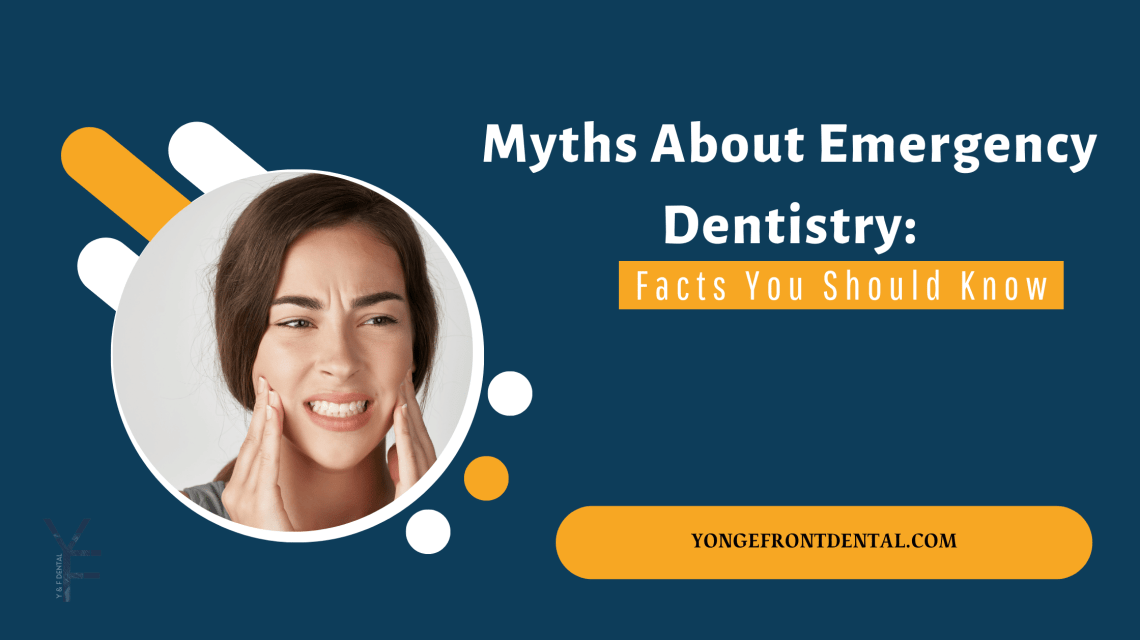Dental emergencies can happen at any time, often when least expected. Whether it is a severe toothache in the middle of the night, a knocked-out tooth from an accident, or a cracked molar after biting into something hard, urgent care is often necessary.
Emergency Dentistry Myths: Facts You Should Know
However, many people hesitate to seek emergency dental treatment due to widespread misconceptions. These myths can lead to unnecessary delays, worsening conditions, and more expensive procedures down the line.
In this article, we will address some of the most common myths surrounding emergency dental care and uncover the facts that everyone should know.
Myth One: Dental Emergencies Can Wait Until Regular Office Hours
Fact: Delaying Treatment Can Make the Problem Worse
One of the biggest mistakes people make is assuming that dental emergencies can wait until their dentist’s next available appointment. While some minor issues may not require immediate attention, certain conditions need urgent care.
For example, a severe tooth infection, known as an abscess, can spread to other parts of the body if left untreated, leading to serious health risks. Similarly, a knocked-out tooth has the best chance of being saved if re-implanted within an hour. Waiting too long could mean permanent tooth loss or a more complicated, costly treatment later.
When should you seek immediate care
- Persistent, unbearable tooth pain
- A knocked-out, cracked, or fractured tooth
- Uncontrolled bleeding from the gums or mouth
- Swelling in the jaw or face
- Signs of infection, such as fever or pus

Myth Two: Emergency Dental Care Is Only for Severe Pain
Fact: Not All Dental Emergencies Are Painful
While intense pain is often a sign of a dental emergency, not all urgent issues come with immediate discomfort. A broken crown, loose filling, or minor crack in a tooth might not cause pain right away, but leaving it untreated can lead to infections or further damage.
A silent issue that often goes unnoticed is a dead or dying tooth. Sometimes, a tooth may stop receiving blood flow due to trauma or decay, yet not cause pain until the surrounding tissue becomes infected. By then, treatment may be more complex.
Examples of non-painful dental emergencies
- A chipped or cracked tooth
- A dislodged dental crown or filling
- A tooth that has changed color, often a sign of internal damage
Even if there is no pain, a visit to the dentist can prevent complications before they arise.
Myth Three: You Can Fix a Dental Emergency at Home
Fact: Home Remedies Are Temporary, Not a Substitute for Professional Care
Many people try to handle dental problems at home using household remedies. While certain first-aid measures can provide temporary relief, they do not replace professional treatment.
For example, applying aspirin directly to the gums is a popular but harmful home remedy. Aspirin is acidic and can burn gum tissue, making the situation worse. Similarly, using clove oil for pain relief may provide a numbing effect but will not address the root cause of the problem.
What you can do at home before seeing a dentist
- Rinse with warm saltwater for temporary relief from swelling
- Use a cold compress for pain and inflammation
- Store a knocked-out tooth in milk or saline to preserve it before re-implantation
What you should not do
- Attempt to glue a broken crown or filling back on
- Use sharp objects to remove food stuck between teeth
- Ignore mild discomfort, assuming it will resolve on its own

Myth Four: Emergency Dental Treatments Are Extremely Expensive
Fact: Delaying Treatment Can Lead to Higher Costs
There is a common fear that emergency dental care will be costly, causing some people to avoid seeking help. While emergency visits may have higher fees than routine appointments, they can prevent much bigger expenses in the future.
For instance, treating a small cavity early costs significantly less than waiting until it develops into an abscess that requires a root canal or extraction. A chipped tooth might only need bonding, but if left untreated, it could break further and require a crown or implant.
Many dental offices offer
- Flexible payment plans for urgent care
- Insurance coverage for emergency procedures
- Financing options to make treatment more accessible
Seeking timely care can save both your teeth and your wallet.
Myth Five: A Knocked-Out Tooth Cannot Be Saved
Fact: Quick Action Increases the Chances of Saving the Tooth
A knocked-out tooth does not always mean permanent loss. If handled correctly and treated promptly, a dentist can reinsert and stabilize the tooth. However, timing is critical. Teeth have the highest chance of survival if they are reinserted within thirty to sixty minutes of being knocked out.
Steps to take if a tooth gets knocked out
- Pick it up by the crown, top part, and avoid touching the root
- Rinse it gently with saline or milk, do not scrub or use soap
- Keep it moist by placing it back in its socket or storing it in milk
- Get to a dentist immediately for re-implantation
A properly handled tooth can fuse back into place with minimal long-term damage.

Myth Six: Emergency Dentistry Is Only for Adults
Fact: Children Also Experience Dental Emergencies
Children are just as prone to dental emergencies as adults, if not more so. Whether it is a fall on the playground, a sports injury, or an unexpected infection, kids may need urgent dental care.
Some parents assume that injuries to baby teeth are not serious since they will eventually fall out. However, damage to primary teeth can affect permanent teeth growing beneath them and lead to misalignment or infections.
Common pediatric dental emergencies include
- Knocked-out or broken baby teeth
- Abscesses or swelling in the gums
- Severe toothaches that interfere with eating or sleeping
Emergency pediatric dental care ensures healthy development and prevents future complications.
Myth Seven: A Chipped or Cracked Tooth Is Not an Emergency
Fact: Even Minor Damage Can Worsen Over Time
A chipped tooth may seem like a minor inconvenience, but if left untreated, it can develop into a more serious problem.
Small cracks can expose the sensitive inner layers of the tooth, making it vulnerable to decay and infections. In some cases, a seemingly small chip can compromise the tooth’s structure, leading to a full break later on.
It is best to have a dentist evaluate any tooth damage, even if it appears minor, to determine the right course of action.

Myth Eight: If There Is No Swelling, It Is Not an Emergency
Fact: Some Dental Problems Develop Without Visible Symptoms
Not all infections or injuries cause noticeable swelling right away. Some conditions, such as deep cavities or gum infections, can develop silently for weeks before showing obvious signs.
Symptoms to watch for, even without swelling
- Persistent bad taste or odor, a sign of infection
- Sensitivity to hot or cold temperatures
- Difficulty chewing on one side of the mouth
Ignoring early signs can result in more complex treatments later, such as root canals or extractions.
Conclusion
Believing in myths about emergency dentistry can lead to poor decisions, unnecessary suffering, and avoidable costs. Understanding the facts can help you recognize when urgent care is needed and how to handle dental emergencies correctly.
If you or a loved one experiences a dental emergency, do not wait. Seek professional care immediately to protect your health and smile. It is always better to act fast than to regret waiting too long.


